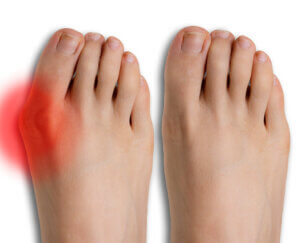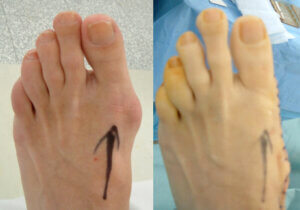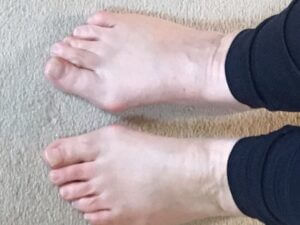Is there a right time and a wrong time to make a decision?

What is the best age for surgery for bunions? This is asked more times than one might imagine. If I add up my surgeries on the bunion over the years, I reckon I have operated on over 3000 feet, and I am by no means an overactive foot surgeon. The bunion, also known medically as hallux valgus, is the most common referral to podiatric surgeons, the group of podiatrists who specialise in elective surgery. You will find many information about this common condition as you navigate my website. We might be obsessed with not having feet like grandmother or mother, but there is a right time and a wrong time to have surgery. This short article is just a get-you-started article. There are more detailed articles, and my book covers four patient case histories in great detail as my patients wrote them without removal of the gory details. I have tried to provide a brief guide based on age. Inevitably, this is only one criterion, but I aim to provide information that will help you consider your options carefully.
Let’s Look at Age Groupings
We might be obsessed with not having feet like our grandmothers or mothers, but there is a right time and a wrong time to have surgery. At the same time, you can be operated on at any age; 35-45 offers optimum results, lower risks, and greater optimism for success. Bunion bump removal surgery (exostectomy) alone is never recommended in the presence of hallux valgus in younger, healthy, mobile, active patients. The short-term benefit and high recurrence from removing bumps make this undesirable.

Under Twenty
Babies can be born with a bunion, but this is rare and considered part of the pressure associated with the uterus; it is just as likely to have a club-shaped foot as a bunion. The latter incidence is around 1 in 1000. The age of bone growth maturity is around 15-17 (girls) and 16-19 (boys). It is possible to have surgery and require a repeat not just once but twice. Our youngest patient was 14, but the most severe bunion was in a 9-year-old.
Children scar more than adults, and this can add to concerns. Surgery at 14 can still require surgery at 20. The only justification for juvenile surgery (under 16) is for pain and damage to the skin with infection. Even surgery as an adult can see recurrence, albeit slower in progression.
The Twenties
Recovery is excellent when young. Return to full function requires little rehabilitation, but skin scars can still appear livid. The recurrence of larger deformities arises frequently, so long-term benefits in later life are not assured.
The Thirties
The deformity reoccurs slightly less after age 30-35 than in earlier years following surgery. Depending upon the source you read, there is a 7-15% reoccurrence risk. Though sometimes it is inevitable. Bunion surgery is successful in 70-80% of cases, but about 20% of patients may not be as satisfied as they might like, and this is a great disappointment for us. Starting a family after thirty+ is common today, especially for those who have yet to settle down or have a significant career. Teachers have more challenges, especially if they have been pressured to return to school too early.One patient, aged 29, took three years for her joint to return to 60 degrees of movement after large surgery. Severe means the deformity was over 45 degrees, and after surgery, it took time to become mobile again.
The Forties
Ages – 40-59 do very well, although healing is slightly slower. Pain control is effective if you follow all the ground rules. Of course, by now, the deformity might have increased, and those secondary features such as hammertoes, corns and a callus may have arisen. Combining surgery with other problems has to be considered, and recovery is longer than when younger. Bunion surgery is carried out more between 40 and 65 than any other age. If your GP says your bunion is not ripe yet, they mean it is not severe enough for surgery. In the UK, this can often be a term to stop the NHS from overloading, where waiting lists are long.
Sixty Plus
Sixty-year-olds remain active today, so it is best to apply the same attitude to someone who wishes to remain active in good health. Our oldest patient was 94 and, while in good health, was troubled by damaged skin. Healing ability can drop, and the skin is more fragile, but pain is better tolerated by many in this age group. Local anaesthetic is much better in the older group, especially if their health is poor. Simple surgery is better, and this is where bump removal is an advantage, restoring earlier mobility and independence. One of our concerns is ensuring patients have someone around to support their needs. You can read — Tales of Foot Surgery from Jane.
Two Feet vs. One Foot
First, you must realise if two feet are operated together, you are DISABLED! This could go on for two to sixteen weeks, depending on how well you do. Reoccurrence? You can be operated on at any age, but 35-45 is still best, with lower risks and greater optimism for success. ‘Young’ is not so good because reoccurrence is higher than thirty-five upwards. However, the joint has less cartilage damage at a younger age, which could deteriorate if left untreated. We can cope with general cartilage wear if the joint is not inflamed.
The golden rule is, can you cope? Does the joint hurt or swell? If you can do all the activities you want, stick with the deformity but protect the skin.
Ladies and Men, Beware
Footwear and bunion surgery don’t always mix well. Surgery is not an excuse to wear shoes that once upon a time exacerbated the problem in the first case. Now, I am not saying that the wrong shoes cause bunions; they don’t, but some of those tighter shoe designs do not help the problems of having a bunion.
Leaving surgery for later is better as a rule
The Exceptions
- infection and ulceration of the skin
- severe skin damage because of pressure
- nighttime pain or continuous pain requiring painkillers
- Lesser toes dislocating
Seek help for these problems. Here is a summary.
Summary
- Try to find a conservative approach to keep you comfortable.
- Very young are not ideal because bunions can reoccur
- Your joint may be stiff after surgery.
- Watch out for correctly fitted shoes after surgery.
- Patients with good mobility do better.
- Surgery, later on in life, can be prejudiced by medical problems and depend on bone quality.
- Healing diminishes with age.
Check out my other articles on bunions
- When is surgery indicated for the bunion?
- Helping your bunion yourself
- Hallux Valgus is known as a bunion
- What do you really need to know after bunion surgery?
The Go-to Book You Can Trust

If you want more details about the after-effects of surgery on your bunion, read these true-life journey stories and the risks behind the scenes. Now, Tim E Kilmartin and I have captured loads more similar tales from the US and UK in our new book, which is out in hardback and, from 8 January 2025, in paperback and digital format (Kindle and tablet). To learn more, listen to David discussing the book on his site.
Click here & on ‘NEW BOOK‘
Thanks for reading ‘Bunion surgery the best age?’ by David R Tollafield
Published by Busypencilcase Communications. Est. 2015 for ConsultingFootPain

David is a full-time author. You can also find his books on his website.







Trackbacks/Pingbacks